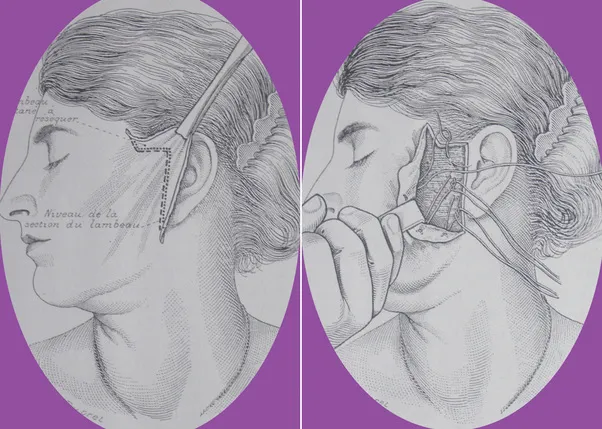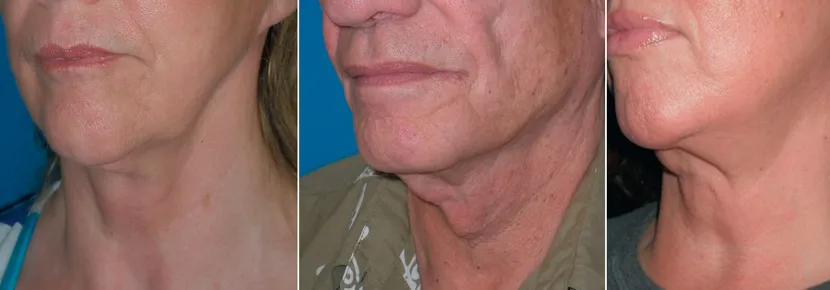
eBook - ePub
The Art and Science of Facelift Surgery E-Book
Joe Niamtu
This is a test
Partager le livre
- 240 pages
- English
- ePUB (adapté aux mobiles)
- Disponible sur iOS et Android
eBook - ePub
The Art and Science of Facelift Surgery E-Book
Joe Niamtu
Détails du livre
Aperçu du livre
Table des matières
Citations
À propos de ce livre
Improved surgical techniques and increasing patient expectations have transformed the field of cosmetic facial surgery, and Art and Science of Facelift Surgery brings you up to speed with today's best and latest procedures. This highly practical resource features a superbly illustrated print reference with step-by-step procedures of each technique. Comprehensive, easy-to-follow instruction from internationally renowned expert Dr. Joe Niamtu helps you achieve optimal outcomes on frequently requested procedures.
- Covers the procedures that today's patients are requesting: male facelift and chin implants, revision facelifts, deep plane facelifts, submandibular gland resection, and many more.
- Includes an abundance of full-color photographs that illustrate surgical steps and before-and-after outcomes, as well as easy-to-follow instruction for each procedure.
- Helps both trainee and practicing aesthetic surgeons attain optimal results and patient satisfaction with every facelift.
Foire aux questions
Comment puis-je résilier mon abonnement ?
Il vous suffit de vous rendre dans la section compte dans paramètres et de cliquer sur « Résilier l’abonnement ». C’est aussi simple que cela ! Une fois que vous aurez résilié votre abonnement, il restera actif pour le reste de la période pour laquelle vous avez payé. Découvrez-en plus ici.
Puis-je / comment puis-je télécharger des livres ?
Pour le moment, tous nos livres en format ePub adaptés aux mobiles peuvent être téléchargés via l’application. La plupart de nos PDF sont également disponibles en téléchargement et les autres seront téléchargeables très prochainement. Découvrez-en plus ici.
Quelle est la différence entre les formules tarifaires ?
Les deux abonnements vous donnent un accès complet à la bibliothèque et à toutes les fonctionnalités de Perlego. Les seules différences sont les tarifs ainsi que la période d’abonnement : avec l’abonnement annuel, vous économiserez environ 30 % par rapport à 12 mois d’abonnement mensuel.
Qu’est-ce que Perlego ?
Nous sommes un service d’abonnement à des ouvrages universitaires en ligne, où vous pouvez accéder à toute une bibliothèque pour un prix inférieur à celui d’un seul livre par mois. Avec plus d’un million de livres sur plus de 1 000 sujets, nous avons ce qu’il vous faut ! Découvrez-en plus ici.
Prenez-vous en charge la synthèse vocale ?
Recherchez le symbole Écouter sur votre prochain livre pour voir si vous pouvez l’écouter. L’outil Écouter lit le texte à haute voix pour vous, en surlignant le passage qui est en cours de lecture. Vous pouvez le mettre sur pause, l’accélérer ou le ralentir. Découvrez-en plus ici.
Est-ce que The Art and Science of Facelift Surgery E-Book est un PDF/ePUB en ligne ?
Oui, vous pouvez accéder à The Art and Science of Facelift Surgery E-Book par Joe Niamtu en format PDF et/ou ePUB ainsi qu’à d’autres livres populaires dans Médecine et Dermatologie. Nous disposons de plus d’un million d’ouvrages à découvrir dans notre catalogue.
Informations
Sujet
MédecineSous-sujet
DermatologieChapter 1
What is a Facelift? History and Semantics
The word facelift has no standard definition because it means different things to different people including patients and surgeons. One can search the Internet and, just to name a few, find:
- • Full facelift
- • Midfacelift
- • Endoscopic facelift
- • Neck lift
- • Filler facelift
- • Vampire facelift
- • Thread facelift
- • Fast lift
- • Quick lift
- • Lifestyle lift
- • Stem cell facelift
- • Facelift dentures
Unscrupulous marketing and promotion has assigned the word “facelift” to any procedure that may or may not lift the face. If a procedure does lift the face (even several millimeters) should it be called a facelift? More often than not, when anyone names a facelift (after themselves or any person, place, or thing) it reeks of promotion. Very frequently, these “special” facelifts are simply a basic facelift procedure with some spin on part of the procedure. They are usually just rehashed verbiage that surgeons or companies use to gain attention to their specific technique. Also in my experience, these types of surgical facelift attempt to eliminate integral parts of the classic facelift procedure. This may be done because the surgeon does not have the expertise to perform classic facelift (including the Superficial Musculo-Aponeurotic System [SMAS], platysma and SMAS management) or the abbreviated lift may be promoted as “easier”, “medical breakthrough”, “shorter recovery”, “more affordable”, and on and on. Unfortunately, this confuses the public and oftentimes leads to poor choices and disappointment on the part of the surgeon. Please do not misinterpret my intentions in this description, I am not attempting to demean any group, surgeon, or company. My main problem with over-marketed hype is that the patient does not realize the standard. Like anything else in life, if it sounds too good to be true, it probably is. If the word “facelift” was standardized, it would represent the classic cervicofacial rhytidectomy, which is a misnomer in itself. Rhytidectomy means “to excise wrinkles” and that is really not what a facelift does. The word, however, has stood the test of time and usually defines a procedure with incisions in front and behind the ear as well as in the submental region. The classic procedure includes undermining flaps of various lengths in various tissue planes, managing surrounding fat through various procedures, treating the SMAS or deep tissues to provide deep suspension and excising excess skin. In my world (and most of my colleagues') that is what a “facelift” is. If I had to define it further, I would call it an “incisional dissection suspending and excision procedure”. I could call it an IDSEP to be grossly descriptive, but then I would enter the same arena as those promotional re-nomenclature. The incision, dissection, suspension, excision procedure is what I refer to as a “comprehensive facelift”. Bcause the procedure actually affects the neck more than the face, I also refer to the procedure as “face and neck lift”. Otherwise, patients may not realize that a “facelift” also improves the neck. To confuse the issue, some surgeons perform an isolated “neck lift” that only uses posterior auricular incisions. Very few patients are candidates for this truncated procedure and it is uncommon. It is important that patients do not confuse this “necklift” with the actual effects of a conventional, contemporary, comprehensive face and neck lift. In common parlance, a facelift is really a “face and neck lift”.
One of the most confusing names is the “full facelift”. About 60% of my facelift consults lead the patient to ask: “Do you mean I need a full facelift?” I always joke with them and tell them I can do a half facelift instead of a full facelift and they choose which side! I believe the term “full facelift” is a holdover from the days when a coronal browlift accompanied most facelifts. This pretty much gave the patient an incision around the entire face when considering the scalp, preauricular and postauricular and submental incisions. Many patients, especially senior ones, associate a “full facelift” with the past incision fest. Also because many facelifts are performed with other cosmetic procedures such as blepharoplasty, browlift, and facial implants, the definition becomes further vague for the patient.
Besides the negative association of the name, facelift surgery has numerous other negative connotations. Before the days of volume addition in the form of fat, implants, and fillers, many facelifts looked very unnatural. This has to do with several factors. First and foremost was the fact that 40 years ago, most patients waited until they “looked old” to have a lift. Many of these patients had skeletonized faces from senescent volume loss and by pulling the skin tight against a gaunt, skeletal face and adding an often over-corrected coronal browlift, patients often looked very unnatural. Definitely tighter, but not necessarily younger. If there are two historical factors that to this day still stigmatize facelift surgery, they are over correction and the lack of volumization. For some reason, many celebrities (who have access to money, travel, and preferred surgeons) end up with extremely unnatural results that scare off many patients from having surgery.
The natural progression of facelift advancements is also a culprit in the negative connotation of the procedure. Historically, early lifts were performed with small skin excisions only. Later suture suspension was added, but these were still primarily “skin only” lifts. With advancement, the platysma and SMAS were treated which provided more natural and lasting outcomes. Older patients may only be aware of the techniques we now call primitive. Along this historical timeline, there have truly been some trial and error “disasters” that are hard to comprehend now (Fig. 1.1).

Fig. 1.1 I have seen several patients present for consultation with posterior cervical scars from a “facelift” to tighten the face.
In addition, the phrase “there is nothing new under the sun” rings true with facelift surgery. Although many surgeons promote short scar, limited incision facelifts with purse string sutures as new or miraculous, they have, in fact, been around for a century (Fig. 1.2).

Fig. 1.2 Although limited incision facelifts with purse string sutures are currently promoted by some as “breakthroughs”, they are in fact a centennial procedure. (From Niamtu, J. Cosmetic Facial Surgery, 2nd ed. (2018). Philadelphia, PA: Elsevier. Fig. 3.3. Page 35)
My job is not to attempt to provide the only definition of this procedure and not to condemn those surgeons who perform abbreviated examples of face lifting. On the contrary, many of today's best facelift surgeons started their journey with smaller, simpler procedures and climbed the learning curve. Just as most general surgeons performed an appendectomy before they did a Whipple procedure, cosmetic surgeons walked before they ran. Although I infrequently perform short scar, limited incision facelifts, they do serve a purpose for select patients with minimal aging. In addition to that, these were the first type of facelifts I performed and they served as a great model and practice for progressing into more comprehensive techniques. Small lifts can be a great learning tool.
Small lifts are also an acceptable technique for doctors who may not have extensive surgical training in the head and neck. Some specialties may perform small lifts as the pinnacle of their surgical offering. There is not a problem with this as long as:
- 1. The patient has minimal aging commensurate with a small lift
- 2. The patient understands the limitation of the procedure in anticipated results
- 3. The patient understands the smaller longevity of the procedure
- 4. The patient understands what the small lift “won't do”
If the aforementioned are followed, a small lift on a patient with minor aging may be the perfect fix. If, however, the patient has moderate to advanced aging and they get a small lift, ethical boundaries are breached. I, unfortunately, see many patients who had short scar, (limited incision) procedures without plastysmaplasty who were totally inappropriate candidates (Fig. 1.3). The result and longevity are substandard and they were in no way, shape or form, candidates for an abbreviated lift. They now have to spend the money all over again to have their aging face improved the right way. Again, there is nothing wrong with smaller lifts, as long as the patient has smaller aging. This will be discussed more in the short scar, limited incision chapter in this book.

Fig. 1.3 These three patients presented to my office within a year of having a heavily promoted short scar procedure that was touted as a “medical breakthrough”. Unfortunately, these patients were treated with a small lift and need a larger lift, hence the poor postoperative results. (From Niamtu, J. ...